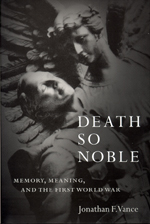Book Review: Death So Noble
In Death So Noble, Jonathan Vance explores how Canadians constructed a collective memory of the First World War based on “fact, wishful thinking, half-truth, and outright invention.”[1] Vance endeavours to explain how Canadians gave birth to the myth and how it became embedded in the collective consciousness in the 1920s and 1930s.[2]
Vance argues that while Canadians waited for the official record of the War they assembled their own story.[3] Canadians were intent on distinguishing the war as just, holding in high regard the ideals of “Liberty, Truth, Justice, Honour, Mercy, [and] Freedom.”[4] To contemporaries, the myth “answered a need, explained the past, or offered the promise of a better future.”[5] Canadians needed a way to justify the atrocities, deal with their grief, and attach meaning to the personal and national losses caused by the war.[6] Vance’s sources include art, music, fiction, memoirs, memorials, film, speeches, elementary school curriculum, and Veteran reunion programs and menus.  He champions these atypical and unusual sources, arguing that flawed writing does not diminish an opinion.[7] In searching to understand the public war myth, Vance chooses not to judge amateur writers against professionals but to evaluate each memoir or poem for its contribution to the myth. Including these primary sources is essential to show that the Canadian public was actively involved in constructing the myth. That the sources are so varied supports Vance’s argument and makes for an engaging read.
He champions these atypical and unusual sources, arguing that flawed writing does not diminish an opinion.[7] In searching to understand the public war myth, Vance chooses not to judge amateur writers against professionals but to evaluate each memoir or poem for its contribution to the myth. Including these primary sources is essential to show that the Canadian public was actively involved in constructing the myth. That the sources are so varied supports Vance’s argument and makes for an engaging read.
Death So Noble is extremely readable. Vance’s sophisticated arguments and detailed citations satisfy an audience of critical historians, but the clarity with which he writes maintains a text that is accessible to a broad audience. Vance includes an impressive array of secondary sources, distilling their arguments and infusing them coherently into his own.
Despite this praise for Death So Noble, Vance’s work has some shortcomings. By focusing primarily on white, English-speaking, British-born Canadians, Vance demonstrates a fundamental bias to his writing that weakens the text as a whole. Attention to aboriginal, French, and immigrant Canadians is negligible until Chapter Eight, “To Found a Country.” Here Vance notes that aboriginal Canadians had one of the highest enlistment rates of any ethnic community, including English Canadians.[8] Despite this evidence of Native support, Vance gives only five pages of the entire book to Native experiences. By neglecting their experiences, Vance perpetuates this unfairness. Vance also claims that “the declaration of war had drawn Canadians together across social, political, religious, and ethnic divisions,”[9] but then argues that the war divided English and French Canadians. This conflict intensifies Vance’s bias. He refers to Quebec Nationalists as “fair-weather friends,”[10] and leaves out any detailed discussion of their experience of the myth. The memories of French Canadian, like Native Canadian contemporaries, are of little consequence to Vance. It seems that what Vance is really saying is that the First World War united European Canadians. Despite the myth of a nation united, immigrant Canadians like the Greek, Japanese, Ukrainian, and African ex-soldiers were not equal to British stock.[11] These groups would have also experienced the myth, perhaps adding to it, or modifying it to reflect their own experiences. Remedying this bias would require exploring how these minority groups participated in creating the myth and how it may have affected them differently because of their social and class differences.
In contrast with his neglect of aboriginal, immigrant, and French Canadian experience, Vance’s discussion of women’s contributions is redeeming. He cites women’s involvement as leaders in the pacifist movement,[12] as writers,[13] nurses,[14] and members of community organizations like the IODE, Women’s Canadian Clubs, and Women’s Institutes.[15] Vance recognizes that women held a significant role in creating and maintaining the myth. Mothers were particularly noteworthy and Vance explores this in detail in Chapter Five, “The Soldier as Canada.”
Death So Noble is an exciting and intriguing understanding of the First World War. By looking at public agency in creating memory, Vance contends that the public’s enthusiasm for building a celebratory myth trumped the reality of over 60 000 soldier deaths. Joyful memorials with roots in self-censored soldier letters[16] perpetuated the myth that soldiers at the front “carried light hearts into battle”[17] and wanted to ease the minds of loved ones at home. Vance successfully shows that these tactics assisted Canadians’ amnesia to the grief, suffering, and loss associated with the war.